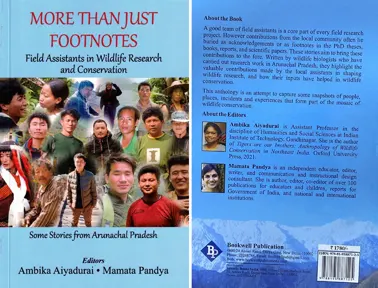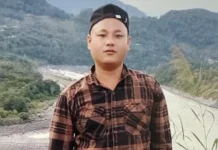Book review
[Sheersha Barik]
Edited by Ambika Aiyadurai and Mamata Pandya of New Delhi-based Bookwell Publication, this book is a fine collection of stories in the form of biographies written by wildlife researchers and forest officers about their field assistants in Arunachal Pradesh.
The valuable contributions of field assistants from different tribal communities often tend to lie buried as acknowledgments or as footnotes in scientific publications. This book attempts to bring these stories to the forefront. The book contains 16 stories, including six women field researchers. The chapters highlight the significant contributions made by the local assistants in shaping wildlife research, gaining an understanding of traditional ecological knowledge and awareness about the social and cultural dimensions of conservation. The inputs from field assistants also help in designing the research projects and in successful implementation of wildlife conservation.
Field-based research in Arunachal, one of the biodiversity hotspots, can be logistically challenging. Therefore, researchers and forest officers often rely on the local communities (village leaders, school teachers, government officials, and host families) who participate in research projects as translators, porters, and guides, identifying animal footprints, counting birds, and fixing camera traps. It is impossible to carry out ecological and social surveys without their tireless support and engagement of field assistants in the process.
Supported by the National Tiger Conservation Authority, the book is considered as first-of-its-kind in India that exclusively documents the significant roles played by the local communities in wildlife research and conservation. Along with the stories of field assistants, the book covers rich information on magnificent wildlife species such as tiger, takin, red panda, and also on frogs, fishes and gliding squirrels. In addition, the chapters also carry socio-cultural aspects of people’s relations with animals, recognising the traditional ecological knowledge and the conservation ethos of the tribal communities.
The book’s main attraction is the front cover, which displays photos of field assistants across Arunachal who largely remain invisible in the wildlife conservation stories. The title ‘More Than Just Footnotes’ completely justifies the aim of bringing the roles of field assistants onto the main stage.
The chapters carry fascinating details of people, species, culture and landscape while covering the contributions of the field assistants. Dr Aisho Sharma Adhikarimayum from the Wildlife Institute of India (Dehradun), in his chapter talks about his field assistant Apiya Jonti Mikhu (or Jonti bhaiya) of Dibang Valley. Jonti bhaiya is the one who suggested that Aisho visit a particular trail, where they saw tiger pugmarks. Later, according to the instructions of Jonti bhaiya, they placed cameras in the area, which captured the first recording of a tiger at the highest elevation in the Indian part of eastern Himalayas. Similarly, ecologist Dr Murali Krishnan Chatakonda of Amity University in his chapter talks about the contributions of his field assistants Biranjoy Basumatary and Erebo Chakma during the nocturnal surveys to study gliding squirrels in the Namdapha Tiger Reserve. Dr Jayanta Kumar Roy, a wildlife biologist at Aaranyak (Guwahati), mentions his visit to Lower Dibang Valley, where he met his field assistants Regon Menda and Gapo Miuli, and later Ahi Mihu, in Anini. He says that the knowledge about forests, cultural practices and local stories that his field assistants shared had helped profoundly in his research on frogs. Their support and guidance helped locate a rare frog species called Nanorana chayuensis, which became a record of sighting this particular species in Arunachal.
These stories are deeply personal and emotional for the researchers. One of the chapters, titled ‘Ajeimai Yun: Gone but not forgotten’, is dedicated to a field assistant. Authored by Prof Ambika Aiyadurai, it is a heart touching story in which she remembers how she found a friend in Ajemai and the gift Ajemai gave, saying “Yeh aapke liye didi” will always be cherished by her. The one line which touched the most and gave a strong feeling of the bonding they shared, as Aiyadurai writes, is: “I knew I would miss Ajemai but did not know that I would never see her again. A month after I completed my fieldwork, I received the sad news that Ajemai was no more.”
The preface of the book reminds us that the story of wildlife conservation in India is not just about charismatic species, or captivating landscapes, or the scientists, but is equally about the local communities whose role is significant. This rare book provides much-needed recognition to the real ‘heroes and heroines’ of Arunachal’s wildlife research, whose contributions must go beyond footnotes. (The contributor is a communication specialist at IITRAM, Ahmedabad, and can be reached at sheershabarik@alumni.iitgn.ac.in)





